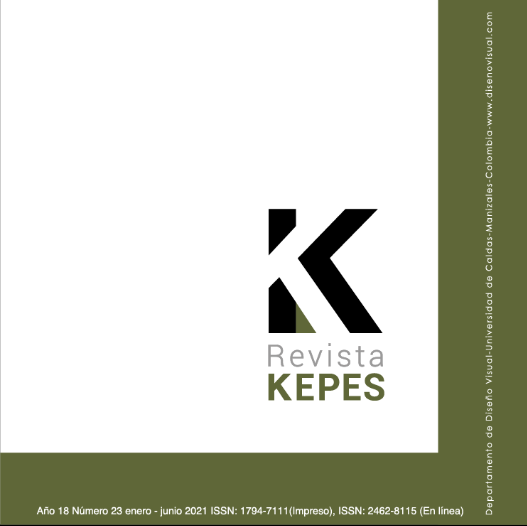Authors
Abstract
Research on design and radical innovation continues to contribute to the emergence of methodologies applicable mainly in European contexts, given their origin. Therefore, our objective was to study the relationship between design and radical innovation from a systemic perspective, focused on the innovation process in industrial SMEs in the city of Guayaquil. An exploratory and descriptive research was chosen under a pragmatic perspective that combines qualitative and quantitative tools, which allowed to have a more comprehensive and complete vision of the phenomenon. The methodology
included two phases, a documentary and an empirical one, which consisted of an in-depth interview with 66 industrial SMEs. Among the main conclusions, we highlight that design is integrated into the radical innovation process when designers have strategic skills, when management has a culture towards the use of design and is identified with the potential of design, and when there are policies that put in value to design in the region. That is, it is not enough to have specialized designers, it is necessary to address not only the individual performance of the parts but also their interactions where three components converge: i. The National Innovation System (SNI), since it will exert many conditions to the development of innovation in a particular territory; ii. The own innovation manag ement system (IMS) of the company which is of vital importance for the fluidity of innovation; and iii. The action of design as a focal actor in this network of interactions.
Keywords
References
Battistella, C., Biotto, G., & De Toni, A. F. (2012). From design driven innovation to meaning strategy. Management Decision, 50(4), 718-743. http://dx.doi.org/10.1108/00251741211220390
BID. (2016). Innovación y productividad en las empresas en América Latina y el Caribe: el motor del desarrollo económico (Matteo Gra). New York. https://publications.iadb.org/publications/spanish/document/Innovaci%C3%B3ny-productividad-en-las-empresas-en-Am%C3%A9rica-Latina-y-el-CaribeEl-motor-del-desarrollo-econ%C3%B3mico-(Resumen).pdf
Borja De Mozota, B. (2006). El diseño de la innovación, dos retos para la profesión del diseño. Innovación y Diseño, 23, 132–146. https://www.raco.cat/index.php/Temes/article/view/51784/104097
Botella, C., & Suárez, I. (2012). Innovación para el desarrollo en América Latina: Una aproximación desde la cooperación internacional. Fundacion Carolina, 78, 20–25. https://www.fundacioncarolina.es/wp-content/uploads/2014/08/AI78.pdf
Cámara de Industrias de Guayaquil. (agosto de 2019). La estructura de abastecimiento en la manufactura ecuatoriana. INDUSTRIAS, 11-15. https://issuu.com/industrias/docs/revista_industria_agosto_2019
Cárdenas, F. (2015). El sector alimenticio del Ecuador se toma el pulso. Gestión, 251, 24-26. https://revistagestion.ec/sites/default/files/import/legacy_pdfs/251_003.pdf
Castañeda, M., Cabrera, A., Navarro, Y., & Wietse, V. (2010). Procesamiento de datos y analisis estadísticos utilizando SPSS. EDIPUCRS. http://www.pucrs.br/orgaos/edipucrs
Chesbrough, H. (2003). Open Innovation: The New Imperative for Creating And Profiting from Technology. Harvard Business School.
Carranco, R. (2017). La aportación de las pequeñas y medianas empresas (pymes) en la economía ecuatoriana. Revista Ciencia Administrativa (2), 146–157. https://www.uv.mx/iiesca/files/2018/03/14CA201702.pdf
Carrió, M. (2006). Espacios comunes del diseño y la innovación. Innovacion y Diseño, 23, 147–155. https://www.raco.cat/index.php/Temes/article/view/51785/104113
CEPAL. (20 de 07 de 2013). Como mejorar la competitividad de la Pymes en la Unión Europea y América Latina y el Caribe: propuestas de política del sector privado. https://www.cepal.org/es/publicaciones/3094-comomejorar-la-competitividad-pymes-la-union-europea-america-latina-caribe
Chandy, R. K., & Tellis, G. J. (2000). The Incumbent’s Curse? Incumbency, Size, and Radical Product Innovation. Journal of Marketing, 64(2), 1–17. https://doi.org/10.1509%2Fjmkg.64.3.1.18033
Cooper, R. (2008). Maximizing Productivity in Product Innovation. Research Technology Management. https://www.researchgate.net/publication/263080371_Maximizing_Productivity_in_Product_Innovation.
Cotec. (2009). Productividad, competitividad e innovación en España: comparación internacional por sectores. Fundación Cotec. https://ocw.bib.upct.es/pluginfile.php/6387/mod_resource/content/1/Estudio_2009.pdf
Cruickshank, L. (2010). The Innovation Dimension: Designing in a Broader Context. Design Issues, 26(2), 17–26. https://www.jstor.org/stable/20749939
Damanpour, F. (1991). Organizational innovation: A meta-analysis of effects of determinants and moderators. Academy of Management Journal, 34(3), 550-590. https://doi.org/10.5465/256406
Dell´Era, C., & Verganti, R. (2007). Strategies of innovation and imitation of product languages. Journal of Product Innovation Management, 24(6), 580-599. https://doi.org/10.1111/j.1540-5885.2007.00273.x
Doing Business. (21 de 07 de 2017). Doing Business. Obtenido de http://espanol.doingbusiness.org/
Guaipatín, C., & Schwartz, L. (2014). Ecuador, Análisis del Sistema Nacional de Innovación. BID, Division de Competitividad e Innovación. https://publications.iadb.org/es/ecuador-analisis-del-sistema-nacional-deinnovacion-hacia-la-consolidacion-de-una-cultura
Hobday, M., Boddington, A., & Grantham, A. (2012). Policies for design and policies for innovation: Contrasting perspectives and remaining challenges. Technovation, 32(5), 272–281. http://dx.doi.org/10.1016/j.technovation.2011.12.002
INEC. (2015). Principales indicadores de actividades de ciencia, tecnología e innovación (ACTI): 2002-2014. http://www.ecuadorencifras.gob.ec/documentos
Jones, M. & Samalionis, F. (2008). From Small Ideas to Radical Service Innovation. Design Management Review, Winter, 20–26. https://doi.org/10.1111/j.1948-7169.2008.tb00102.x
Kelly, T., & Littman, J. (2010). Las diez caras de la innovación. Barcelona: España.
Leifer, R., McDermott, C., Colarelli, G., Peters, L., Rice, M. & Veryzer, R. (2000). Radical Innovation: How Mature Companies Can Outsmart Upstarts. Rensselaer Polytechnic Institute.
Lemarchand, G. a. (2010). Sistemas nacionales de ciencia, tecnología e innovación en América Latina y el Caribe. UNESCO, 329.https://www.epn.edu.ec/wp-content/uploads/2017/03/sistem-nacion-cyt.pdf
Namakforoosh, M. (2005). Metodología de la investigación. México: Limusa.
Norman, D. & Verganti, R. (2014). Incremental and radical Innovation: Design rearch vs technology and Meaning Change. DesignIssues, 30(1), 79-96. http://www.verganti.com/wp-content/uploads/2017/01/NormanVerganti.pdf
Noble, C. (2011). On Elevating Strategic Design Research. Journal of Innovation Managment, 389–393. https://doi.org/10.1111/j.1540-5885.2011.00808.x
OCDE & EUROSTAT. (2005). Manual de Oslo, Guia para la recogida e interpretación de datos sobre innovación. Tagsa. http://www.oecd.org/centrodemexico/laocde/
Property Rights Alliance. (20 de 07 de 2017). INTERNATIONAL. Obtenido de https://internationalpropertyrightsindex.org/
RICYT. (22 de 08 de 2017). Red de Indicadores de Ciencia y Tecnología -Iberoamericana e Interamericana. Obtenido de http://www.ricyt.org/
Rothwell, R. (1994). Towards the Fifth-generation Innovation Process. International Marketing Review, 11(1), 7-31. https://doi.org/10.1108/02651339410057491
Slater, S. F., Mohr, J. J. & Sengupta, S. (2014). Radical product innovation capability: Literature review, synthesis, and illustrative research propositions.
Journal of Product Innovation Management, 31(3), 552–566. http://doi.org/10.1111/jpim.12113
Tether, B. (2005). The Role of Design in Business Performance. Design, 1–26. http://www.bis.gov.uk/files/file14796.pdf
Velasco, E., Zamanillo, I., & Gurutze, M. (2005). Evolución de los modelos sobre el proceso de innovación: Desde el modelo líneal hasta los sistemas de innovación. Decisiones Organizativas, 1–15. http://doi.org/10.1111/aman.12336
Yannou, B., Jankovic, M., & Leroy, Y. (2011). Empirical verifications of some radical innovation design principles onto the quality of innovative designs. In International Conference on Ingineering Design, ICED 11. https://www.designsociety.org/publication/30420/EMPIRICAL+VERIFICATIONS+OF+SOME+RADICAL+INNOVATION+DESIGN+PRINCIPLES+ONTO+THE+QUALITY+OF+INNOVATIVE+DESIGNS
Zúñiga, P. (2010). La necesidad de innovar. El camino hacia el progreso de América Latina y el Caribe. Banco Interamericano de Desarrollo. https://publications.iadb.org/es/la-necesidad-de-innovar-el-camino-haciael-progreso-de-america-latina-y-el-caribe
Zurlo, F. & Cautela, C. (2014). Design Strategies in Different. DesignIssues, 30(1), 19-35. https://www.jstor.org/stable/24267023

 PDF (Español)
PDF (Español)
 FLIP
FLIP






















